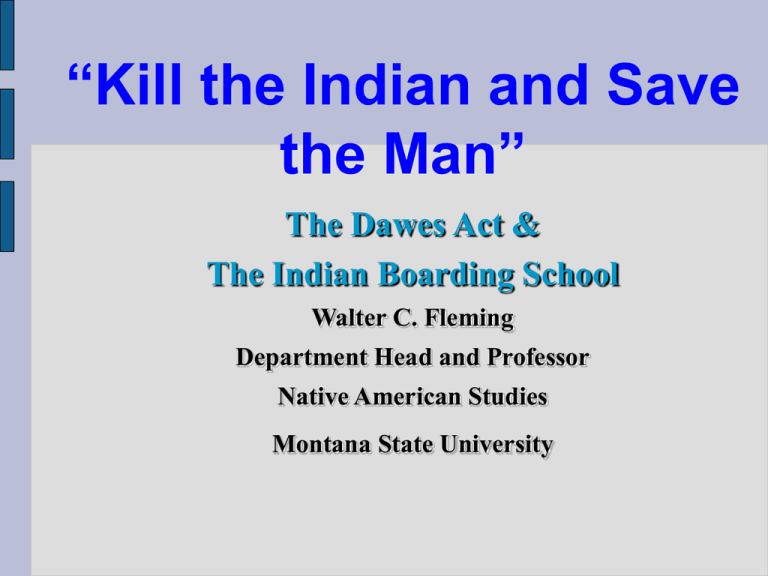The Dawes Act - The West as U.S.
advertisement

“Kill the Indian and Save the Man” The Dawes Act & The Indian Boarding School Walter C. Fleming Department Head and Professor Native American Studies Montana State University Reservation System In 1848, gold was discovered on the South Fork of the American River at Sutter's Mill, near Coloma, bringing a rush of fortune seekers from around the world In order to clear the way for white settlement, the U.S. Senate in 1853 authorized three commissioners to negotiate treaties with the Indian tribes in California. Eighteen treaties were negotiated. The Indian tribes agreed to give away millions of acres of land in exchange for the U.S. government's promise of protection and lands with adequate water and game to sustain them and their way of life. These lands would have contained about 7.5 million acres, or 7.5 percent of the land area of California. The Indians began moving to their new lands only to find out that the U.S. Senate had refused to ratify their treaties. A System of Military Posts Instead of the treaties, the U.S. decided on "a system of military posts" on government-owned reservations. Each of these reservations would put into place a "system of discipline and instruction." The cost of the troops would be "borne by the surplus produce of Indian labor." No treaties were to be negotiated with the Indians; instead they would be "invited to assemble within these reserves." Native people were rounded up at gunpoint and forced to march to the "reservations." Creation of Reservations Treaty (e.g., Flathead Reservation created as the Jocko Reserve by the Stevens or Hellgate Treaty in 1855 Executive Order (e.g., Northern Cheyenne Reservation, created as the Tongue River Reservation in 1884 by President Chester A. Arthur) Act of Congress (e.g., Blackfeet Reservation, created in 1888) Allotment and Assimilation Era 1880 - 1934 “Resistance is futile.” “Getting Civilized” Via Christianization Via Education Via Land Ownership Via Christianization Two Fronts Religious suppression Religious supplantation Religious Suppression Courts of Indian Offenses The Courts of Indian Offenses were first established by Commissioner Price in compliance with instructions issued by Secretary of the Interior Teller December 2, 1882. Secretary Teller, writing to Commissioner Price on this subject, stated that there were certain practices among the Indians he felt should be discouraged. He mentioned the injurious phases of certain dances and rituals, plural marriage, the medicine man and the destruction of property following death. The rules promulgated by the Commissioner stipulated that it should be known as the "Court of Indian Offenses," and that it be presided over by three Indians, each to be styled "Judge of the Court of Indian Offenses." The first three ranking officers of the Indian Police force were to be designated as Judges. Appeals might be taken from the Indian Court to the Indian Bureau. The Indian Bureau Regulations issued September 22, 1884, established these courts. The Indian Bureau Regulations of April 1, 1904, reveal little change in these regulations. Under the 1904 Regulations, the offenses consisted of participating in a Sun Dance, entering into plural marriage, operating as a "Medicine Man," destruction or theft of property, giving or offering money to a friend or relative to procure a girl for the purpose of cohabiting with her, intoxication or the trafficking in intoxicants, and unauthorized leaves of absence from the reservation. 4th. The "sun-dance," the "scalp-dance," the "wardance," and all other so-called feasts assimilating thereto, shall be considered "Indian offenses," and any Indian found guilty of being a participant in any one or more of these "offenses" shall, for the first offense committed, be punished by withholding from the person or persons so found guilty by the court his or their rations for a period not exceeding ten days; and if found guilty of any subsequent offense under this rule, shall by punished by withholding his or their rations for a period not less than fifteen days, nor more than thirty days, or by incarceration in the agency prison for a period not exceeding thirty days. Supplement to Circular No. 1665 February 14, 1923 Indian Dancing To Superintendants: At a conference in October, 1922, of the missionaries of the several religious denominations represented in the Sioux country, the following recommendations were adopted and have been courteously submitted to this office: 1.That the Indian form of gambling and lottery known as the 'ituranpi' (translated 'Give Away') be prohibited. 2.That the Indian dances be limited to one in each month in the daylight hours of one day in the midweek, and at one center in each district; the months of March and April, June, July, and August be excepted. 3.That none take part in the dances or be present who are under 50 years of age. 4.That a careful propaganda be undertaken to educate public opinion against the dance and to provide a healthy substitute. 5.That there be close cooperation between the Government employees and the missionaries in those matters which affect the moral welfare of the Indians. These recommendations, I am sure, were the result of sincere thought and discussion, and in view of their helpful spirit, are worthy of our careful consideration. They agree in…… Religious Supplantation 1890’s; Congress appropriated funds to religious denominations to administer schools on reservations Much of the funds came from “Tribal Funds” – proceeds from the sale of tribal lands. “Monopoly on Indian Souls” Commission of Indian Affairs Report, 1881-1882 Hicksite Friends Orthodox Friends Presbyterians Christians Methodists Catholics Reformed Dutch Congregationalists Episcopalians Unitarians Lutherans 6 reservations 10 9 2 14 7 5 3 8 2 1 Remember the Constitution? Bill of Rights Amendment I Congress shall make no law respecting an establishment of religion, or prohibiting the free exercise thereof; … Via Education Boarding Schools First was Carlisle Indian School, Carlisle, Pennsylvania Established 1879 Captain Richard Henry Pratt Former Commanding Officer of the 10th Cavalry (“Buffalo Soldiers”) Worked with 72 Indian Prisoners at Fort Marian, St Augustine, Florida Civilization via Immersion "In Indian education I am a Baptist, because I believe in immersing the Indian in our civilization and when we get them under holding them there until they are thoroughly soaked." “Kill the Indian … “A great general has said that the only good Indian is a dead one, and that high sanction of his destruction has been an enormous factor in promoting Indian massacres. In a sense, I agree with the sentiment, but only in this: that all the Indian there is in the race should be dead. Kill the Indian in him, and save the man....” Off-reservation Boarding Schools Carlisle – 1879 Chemawa – 1880 Albuquerque - 1884 Chilocco - 1884 Sante Fe - 1884 Haskell – 1884 Stewart – 1890 Phoenix – 1890 Pierre – 1891 Flandreau - 1893 Tom Torlino, Navajo (1882 and 1885) Via Land Policies General Allotment Act AKA “Dawes Act” Passed in 1887 Introduced by Senator Henry A. Dawes, Massachusetts Dawes Speaks for America “Inasmuch as the Indian refused to fade out, but multiplied under the sheltering care of reservation life, and the reservation itself was slipping away from him, there was but one alternative: either he must be endured as a lawless savage, a constant menace to civilized life, or he must be fitted to become part of that life and be absorbed into it.” Teddy Roosevelt “… a mighty pulverizing engine to break up the tribal mass.” TERMS OF THE DAWES ACT 1. Divided tribal lands into small plots for distribution among members of the tribe. 2. Each family head received 160 acres. 3. Once land was distributed to Native Americans, any surplus was sold to white settlers with the profits of those sales going to Native American schools. 4. To keep the Native Americans' land from falling into the hands of speculators, the federal government held it in trust for 25 years. 5. Finally, American citizenship was granted to Native Americans who accepted their land, lived apart from the tribe, and adopted the habits of "civilized life." Yeoman Farmers Winter of 1886-87 60 Percent of cattle died in Montana 80°F Wind chill during the worst storm Jan. 29-Feb. 4, 1887 Scenario One 1,000,000 acre reservation 320 acre allotments 3,125 allottees 1,000,000 acres allotted 0 acres “surplus” Scenario Two 1,000,000 acre reservation 320 acre allotments 1,000 allottees 320,000 acres allotted 780,000 acres “surplus” Scenario Three 1,000,000 acre reservation 320 acre allotments 4,000 allottees 1,280,00 acres needed to allot to all eligible 280,000 allotted on other reservations and public lands (Turtle Mountain) OUTCOME OF DAWES ACT Indian Lands Sold and Alienated 1887 - 1934 Type Acres Surplus Reservation Land Sold Allotted Land Sold or Alienated Ceded Reservation Land Miscellaneous Losses 22,694,658 23,225,472 38,229,109 3,474,217 Total 87,623,456 From Indian Land Tenure, Economic Status and Population Trends, Land Planning Committee, Washington, D.C., US Government Printing Office, 1934, p.12. Net Loss Total Area of All Reservations, 1887 130,730,190 Total Area of All Reservations, 1934 43,035,734 Net Loss 67% MONTANA RESERVATIONS AND LANDS 1 TRUST RESERVATION TOTAL AREA TRIBAL TRUST % TOTAL TRUST ALLOTTED INDIVIDUAL TRUST Blackfeet 1,525,712 242,973 25.9 % Crow 2,282,764 403,577 26.4 1,122,964 73.6 Flathead 2 1,242,969 573,629 92.4 47,026 651,119 210,954 34.5 2,093,124 386,523 N. Cheyenne 440,157 Rocky Boy’s Fort Belknap Fort Peck 3 TOTALS SOURCE: 74.1 % TOTAL TRUST 939,009 % TOTAL AREA NON-TRUST LAND 61.5 % 586,703 1,526,541 66.9 756,223 7.6 620,655 49.9 622,314 400,227 65.5 611,181 93.9 39,938 42.2 528,628 57.8 915,151 43.7 1,177,973 307,432 69.8 127,087 30.2 434,519 98.7 5,638 108,015 108,015 100.0 0 0.0 108,015 100.0 0 8,343,860 2,233,103 43.3 2,921,968 56.7 5,155,071 61.8 3,188,789 Report No. 55-38-X FY82 Bureau of Indian Affairs Billings/Portland Regional Offices 696,035 % TOTAL TRUST MONTANA RESERVATIONS: LAND USE 1 RESERVATION Blackfeet TRUST INDIAN USE % INDIAN USE 22 NON-INDIAN USE % NONINDIAN USE TRIBAL TRUST 939,009 813,529 86.6 % 125,480 13.4 % 14,306 1,526,541 575,337 37.7 951,204 62.3 24,848 Flathead 620,655 590,885 95.2 26,930 4.3 Fort Belknap 611,181 491,432 80.4 119,749 Fort Peck 3 915,151 393,197 43.0 N. Cheyenne 434,519 434,119 Rocky Boy’s 108,015 5,155,071 Crow TOTALS SOURCE: % OF TOTAL %O TO 111,174 8 2.6 926,356 9 10,305 38.3 16,625 6 19.6 58,053 48.5 61,696 5 513,383 56.1 186,672 36.4 326,711 6 99.9 400 0.1 0 0.0 400 10 108,015 100.0 0 0.0 0 0.0 0 3,406,514 66.1 1,737,146 33.7 294,184 16.9 1,442,962 Report No. 55-38-X FY82 Bureau of Indian Affairs Billings/Portland Regional Offices 11.4 % INDIVIDUAL TRUST 8 You do the math! 10 acres per AUM (Animal Unit Month) 32 AUM $ 1.35 per AUM $43.20 per month or $ 172.80 for four month lease of 320 acres of reservation land. Lessee One $ 172.80 for total 320 acres Lessee has a .15306 interest in whole 17,717,616,000 / 115,755,091,200 .15306 X $ 172.80 = $ 26.45 $ 26.45 ! Lessee Two $ 172.80 for total 320 acres Lessee has a .000000027 interest in whole 3,124 / 115,755,091,200 = .0000000269880351 .000000027 X $ 172.80 = $ 00.00000000046656 $ 00.00000000046656 ! Eroding Sovereignty Major Crimes Act, 1885 jurisdiction for certain criminal acts transferred from tribes to Federal Courts Indian Citizenship Act, 1924 granted US citizenship to Indians



